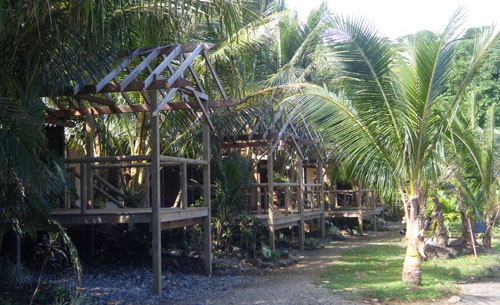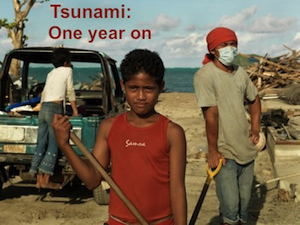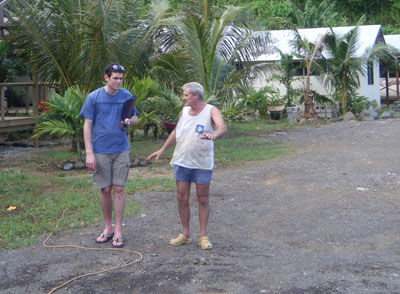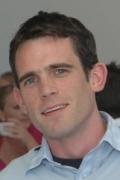
TSUNAMI SPECIAL REPORT 2: Seabreeze Resort in Samoa still has a long way to go to rebuild after last year’s disaster and can only thank volunteer help for the survival of their business. Chris Booth took time out from his busy building timetable to recount his story of survival and his plans for reopening.
APIA: Coming up a rise on the Main South Coast Road on Upolu, the sign to Seabreeze Resort has a wooden cross in front of it, signaling that it is still not open for business.
When walking down the steep driveway, the sounds of hammers, electric saws and Samoan radio blaring confirm that the owners, Chris and Wendy Booth, are hard at work.
 Chris has once again found himself back in the building trade, after retiring from his job on Queensland’s Sunshine Coast six years ago.
Chris has once again found himself back in the building trade, after retiring from his job on Queensland’s Sunshine Coast six years ago.
Samoa tsunami logo
”Oh, I’m a builder mate, I just took off my belt when you came in,” he says.
His wife, Wendy, spent 15 years as an accountant and looks after the bookkeeping side of the business.
Looking out to see from the small narrow cove, Chris Booth points out where the restaurant used to be.
Completely destroyed
”It used to sit out there, but the wave completely destroyed it,” he says.
”It was all lost, even the sea wall it was sitting on was smashed up and sucked out.”
On the other side of the cove stands the honeymoon fale, in which the couple was staying when the tsunami hit.
”There were four waves that hit, two from one angle and then two bigger ones coming from another angle,” he says, pointing out to sea.
Standing on the deck, you can understand why they lived out on the point. It also gave Booth a view of the vast reef in the few minutes between the earthquake and the tsunami.
”There wasn’t even time for the water in the cove to empty,” he says. ”But the whole ocean behind it was just sucked away.
”I yelled across the cove to the cook in the restaurant and pointed out to sea.
“He thought I was talking about the fish, until he came out and had a look himself.”
After the earthquake hit, all the guests had come out of the units, which back into the steep cliff wall of the cove.
”They all got out alright, as I was yelling and whistling to them to run up the hill.”
Holding on for life
Fortuitously, the area is small and steep so the guests did not have far to go up the road to high ground. While the guests and staff escaped easily, Chris and Wendy Booth’s own story is one of desperate survival.
”We just didn’t have time to go from here,” says Booth, standing on the deck of the honeymoon suite.
”I ran inside with my back to the ocean and Wendy looked over my shoulder and said, ”Tsunami!”
”First there was nothing there but the reef, but seconds later, the ocean just leapt up from nowhere.
”The speed and the sound were terrifying.
”It was like a jumbo jet.
”Crushing, breaking, wood and nails and glass, all our clothes and shoes. Everything was thrown into the mess.”
As the wave hit the fale, the couple were thrown into the doorway at the back and Booth told his wife to hang on to anything she could. She ended up hanging on to him.
All Booth had to grasp was the tiny wooden edge of the door frame, which still bears the marks of his finger nails.
Somehow, with all the force of the waves, first hitting, and then sucking out, and with Wendy clutching onto Chris Booth, he managed to hold on.
”My hands were sore for weeks,” he says.
”If we had ended up down in the churning water with all that debris, we would have had no chance.”
”It was a bubbling, churning mess, with wood and glass everywhere.
‘‘There are still three cars down there. I think they’d be great for snorkeling but Wendy thinks it will scare people away, so we’ll tow them out eventually.”
Looking down from the fale to the water allows a chilling idea of the height of the wave. The two bigger ones came right over the roof of the suite, which is at least 8m above the water.
Long downtime
Chris Booth is a hardy, weathered man, with a sense of humour and a strong will. The fact they survived the wave gives them greater hope that they will last the distance and survive the extremely long downtime their business has suffered.
While most other resorts have been open and operating for weeks or months, Seabreeze appears way behind the play.
There is good reason for that but Chris Booth has learnt to weigh his words in a way that his lawyer would be proud.
”We have an insurance claim that is not fully settled,” he says.
”So we have had to take the drastic step of issuing court proceedings against the insurer in the Supreme Court of Samoa.”
Thankfully the Development Bank of Samoa approved a loan for the restoration and the New Zealand government provided the subsidies for the low-interest loans that were taken up by many operators.
As Seabreeze is more than the basic beach fale operation, they did not qualify for the handy Tourism Tsunami Beach Fale Re-building Programme (TTRP), which was financed by the New Zealand government with the help of the United Nations Development Programme. That money meant most of the 50-odd beach fale operators could rebuild quickly.
However, Booth is extremely appreciative of the help they received from New Zealand.
“New Zealand had the foresight to protect the tourism industry and secure overseas money,” he says.
Volunteer help
He is also grateful to the New Zealand architect who came down from his holiday at Sinalei Resort to offer his services for free. The architect put him in touch with an engineering company and they too have decided not to charge.
On top of all that, Booth called up lawyers in Auckland asking for advice, knowing he couldn’t afford it and the call finished with the lawyers offering to run the action pro bono.
”We just couldn’t have done it without their help,” he says.
”It’s amazing really.”
 Tone changes
Tone changes
But his tone changes when Australia is mentioned.
”Look Australia helps Samoa with a lot of aid, and their response was great, but I haven’t got a cent from them personally,” he says.
”Even in the days after the tsunami, the Aussies kept going straight past us on to Lalomanu, but the New Zealand Air \Force came in here to clean up the debris.”
”Australia even approved $1000 grants to Australian residents affected by the tsunami. I’m a citizen, but not a resident, so we didn’t even get that.”
”I don’t envy other people and we’re grateful to have just survived, but it’s been hard yakka,” he says.
”We’ve had to start again, just after I had built some new fales and upgraded the resort in the year and months before the tsunami.”
Samoa is home
Booth has not been back to Australia since making the career and lifestyle move six years ago, and he has no intention of returning.
He enjoys the simple lifestyle and although the couple have to work hard, they love Samoa and it has become their permanent home.
Tourists are already booking in for March, when Booth hopes to reopen. It will be almost one year after Sinalei Resort reopened its doors.
”But we had it tougher than them and many others,” says Booth.
”They had their restaurant and key services on higher ground and could open up while still rebuilding fales.
”We lost the restaurant and if you can’t feed people you can’t have guests.”
There is still nothing but a broken sea wall where the restaurant used to be. Most of the units are well on the way to completion but the swimming pool area is simply marked out with a long garden hose at the moment.
Booth is certainly ready for the challenge and the experience has only hardened his resolve. He is simply getting on with the job.
”We’re also putting in a new emergency ramp on the other side of the cove, so it is quicker for people at that end to escape,” he says.
One thing is for sure, the work keeps him going and at the end of the day, there’s a cold beer and that amazing view.
”I just sit here on the deck and call my mates from Australia,” he says with a laugh.
”It’s just beautiful. I’ve got the life.”
Pictures: Logo: Cleaning up in the wake of the tsunami. (Photo: Jane Ussher/Oxfam.); reporter Alex Perrottet walking with Chris Booth where the planned pool will be constructed. Photo: Alex Perrottet/PMC



